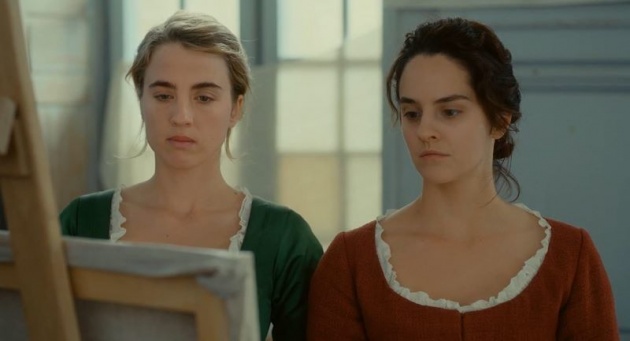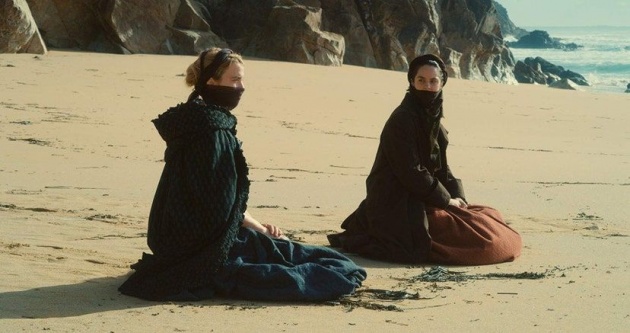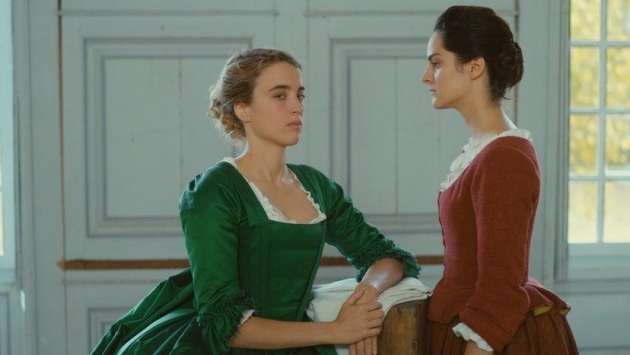
Pictured: Héloise (Adèle Haenel, left) examines a canvas while Marianne (Noémie Merlant, right) looks on in the 2019 film 'Portrait of a Lady on Fire', written and directed by Céline Sciamma. Still courtesy of Curzon Artificial Eye (UK), NEON (US)
Contains spoilers
In the course of this blog series, interrupted in terms of ‘proof of concept’ by the outbreak of COVID-19, I have been on the look-out for game changing movies from women directors, sometimes in terms of box-office success – the justification to allow women to make the movies that they want with the resources they need – but also in terms of artistic achievement. Writer-director Céline Sciamma’s Portrait d’une jeune fille en feu (Portrait of a Lady on Fire) is an example of the latter. Widely acclaimed in the build-up to its UK and US release in February 2020, when it was positioned as a Valentine’s Day movie, and winner of the best screenplay at the 2019 Cannes Film Festival, beating Quentin Tarantino (well, who really is a fan of Once Upon A Time … in Hollywood?) this French romantic drama is one of the few movies in this series that might be considered a classic – something to be talked about and referenced in years to come.
It is a drama that reflects on the nature of art – its rules and conventions. It also looks variously at: romantic love, sacrifice, abuse of women by unseeing and unseen men – most of the cast is female, the number of lines of dialogue given to men in the movie is under ten (and one of those is ‘bonjour’) – fate and the disguise that a female artist has to adopt in order to exhibit their work. It is also about the influence of the subject on the work that is created, something that is not always highlighted. Without models, would we have any great art? Or it would it just be Rothko-like blocks of paint?
It is also a drama about two women in love in a society where such relationships are not permitted. The action takes place in the most part on an island during an unspecified time period – pre-revolutionary and possibly 18th Century. Ultimately, the biggest clue to when it is set is the use of composer Antonio Vivaldi’s The Four Seasons, first performed in 1725. It is also worth mentioning that there is no extra-diegetic music in the movie, no prodding to tell you how to feel. The only music we hear is played by or for the characters, including an eerie clapping song.
It begins with lines on a page, tentative markings by young women artists intercut with the credits. Closer inspection reveals only two identifiable sleeves, one wearing a brown dress, the other wearing blue. Marianne (Noémie Merlant) is modelling in a blue dress in front of a class of six young girls from well-to-do families. The daughter of a (male) artist, having taken over the family business, she is training the next wave, paying it forward. She instructs them to look at her closely: her outline (‘silhouette’) and posture, where she holds her hands, right palm positioned just above her left wrist. Her concentration is broken when she sees one her canvasses at the back of the room. It is a night scene. A woman, low in the frame, is standing, her blue dress is on fire at the hem. ‘What’s that doing here?’ There is a pause. ‘I brought it out,’ confesses one of the students. ‘Should I have?’ A second pause. ‘No.’ ‘What’s it called?’ asks one of the students as the camera moves towards the canvas to give us a better look. Sciamma cuts to the camera moving towards Marianne’s face. ‘Portrait d’une jeune fille en feu.’ Sciamma holds the close-up for about two seconds to catch Marianne thinking. There is a match-cut to Marianne on a boat being rowed across a body of water.
Sciamma pays attention to production design. On one of the rower’s tunics, there is a rip on the shoulder, caused no doubt by his work. These are men who do not have a change of clothes – neither for that matter does Marianne. The boat sways from side to side. Marianne clutches the heavy wooden box containing her canvases. With one tip, the box is in the water. Still wearing her shoes, Marianne dives in to save it. She hangs on to the box containing her canvasses like a woman clinging to a life raft. Significantly, none of the men in the boat comes to her aid. This point is underlined when, still dripping wet, Marianne carries the frame and her sack of materials up a steep incline without assistance. Calling down the hill, she asks for direction. A semi-helpful man advises her to walk in a straight line.
Reader, she arrives. The door is opened by a young maid, Sophie (Luàna Bajrami) who shows her to her quarters – a reception room that is no longer used. Marianne opens the crate and touches the surface of the canvas inside, sodden with water. In an early striking image, Marianne sits naked (leaning forward) by the fire, sandwiched (so to speak) by two drying canvases.
Appropriately attired and sneaking down to help herself to some bread and cheese – we have already established that people do not do things for the young artist – Marianne is greeted again by Sophie. She asks for some wine. She quizzes the maid. How long has she been at the house? ‘Three years.’ What does she can tell her about the young lady? Sophie does not know her very well. Héloise (Adèle el) has only been at the house for four weeks, having recently returned (we discover later) from a convent. Héloise had posed for a male artist, but it did not work out. Later, in a reveal reminiscent of a horror movie, Marianne discovers the canvas facing away from her. She turns it around and see Héloise’s features distorted by a dismissive smear of unsettled paint.
Marianne’s benefactor is Héloise’s mother, the Countess (Valeria Golino). She has engaged Marianne to pose as a companion for long walks and the like. Marianne must paint Héloise’s portrait in secret, stealing looks when she can. For the lower part of the painting, Sophie poses for her. Héloise’s sister committed suicide after becoming pledged to wed a nobleman in Milan. The painting of Héloise is to be sent to him. If he likes it, they will wed. Like any participant in an arranged marriage, Héloise is not mad keen. Marianne got the job because her father painted the countess’ portrait many years. ‘I arrived at a new home greeted by an image of myself,’ the Countess explains, half-exalted, half-appalled. The Countess, we realise, was married off in the same way as Héloise is destined to be. What other choice does she have?
Héloise’s first appearance is dramatic. Marianne gets the call that she must accompany her for a walk. She races down the stairs and sees a hooded figure leaving the house. Marianne follows her. The figure walks faster, her hood flops down, revealing her blond hair. Héloise starts running and heads towards the cliff, the same one from which her sister had plunged to her death. Marianne gives chase and watches Héloise reach the edge of the cliff and turn round. ‘I’ve dreamt of doing that,’ explains Héloise. Jumping off a cliff? ‘Running.’ The pair walk down to the water’s edge.

Pictured: ‘Do you think I can swim?’ Héloise (Adèle Haenel, left) asks Marianne (Noémie Merlant) in ‘Portrait of a Lady on Fire’, a period drama in French written and directed by Céline Sciamma. Still courtesy of Curzon Artificial Eye (UK), NEON (US)
‘Do you think I can swim?’ Héloise asks. Marianne does not recommend it. The tide is too strong. She could get pulled under. Héloise semi-undresses and throws herself into the sea. Marianne does not follow her. Her conclusion: Héloise can float.
Héloise asks if Marianne has a book. Marianne loans her a book about the lyre-strumming Greek hero, Orpheus, who travelled to the Underworld (also known as Hades) to rescue his beloved Eurydice. At one point, Héloise, Marianne and Sophie discuss the Orpheus story. Orpheus is advised by the King of the Underworld that he can bring Eurydice back with her so long as he does not look at her. The pair almost make it back to the surface of the earth when Orpheus turns round and looks at her. Eurydice dies or rather disappears. Scholars have long puzzled why he turned round to deliver his killer look. Was he impatient? Or did he want to live the rest of his days with a single glance of her, fixed in his memory for eternity. The two explanations are that of the lover or the poet. There is a third conjecture: Eurydice called to her. In other words, she willed her fate, to remain dead. Orpheus could not help but respond to her call.
Sciamma uses the story to inform the relationship between Marianne and Héloise. Marianne too has a look that will determine Héloise’s fate. Her rendering could lead to Héloise’s imprisonment in marriage. Marianne informs her of the upside: in Milan, she can listen to music. On a piano, Marianne plays her favourite piece of music, talking her through it. Marianne’s memory of how to play the piece does not do it justice, but Héloise is transfixed (as are we) especially Marianne’s explanation of what the music is doing.
At the end of the sixth day (just like God in Christian theology), Marianne has finished her work. She asks the Countess if she can show it to Héloise – to be truthful about her reason for visiting. Héloise is disappointed about the deception but even more upset that Marianne does not like the picture herself. Try as she might, Marianne could not get Héloise to smile. She is pictured in a green dress, left hand over right wrist in artistic repose. The left hand has a pacifying role. Hurt by Héloise’s words, Marianne too wipes out the image of Héloise’s face. The Countess too is appalled. She had made plans. Marianne was to travel back with her and receive another commission: to paint one of the Countess’ friends who ‘is rather ugly’. The Countess dismisses Marianne as talentless. Then Héloise asks if Marianne can stay. She will pose for her. The Countess scarcely believes it but agrees. You wonder why she is travelling, but if she did not, the story would not progress.
In the second half of the film, Marianne, Héloise and Sophie bond. When Marianne suffers from menstrual pains, Sophie recommends heated cherry stones. Sophie herself has missed several periods. She is pregnant. If she went full term, she would surely lose her job. Marianne and Héloise attempt to terminate the pregnancy by shoving the young woman between them along the beach. In another scene, Sophie hangs from a beam somewhere off screen, then falls (almost comically). This is also unsuccessful. The three young women go out at night where there is some form of celebration. Women start clapping and burst into wordless, rhythmic song. It is here that the hem of Héloise’s catches fire as she stands (perhaps looking at Marianne from a distance) oblivious to impending danger. The flames are smothered in time.
Sophie’s pregnancy illustrates how women are used and dismissed. The eventual abortion scene is striking. An old woman does her work as Sophie stares a young baby whom the old woman is normally minding. As Sophie winces in pain, the baby moves towards her, smiling or at least content. This image inspires Héloise. A painting: Héloise plays the abortionist while Sophie recreates her position. Marianne works quickly on the outline. The picture is subversive, not contrived in accordance with rules and conventions. Héloise is looking at the woman she does not want to become, a young pregnant woman. She is looking an alternate fate for herself.

Pictured: Héloise (Adèle Haenel, left) poses for Marianne (Noémie Merlant) in ‘Portrait of a Lady on Fire’, a period drama in French written and directed by Céline Sciamma. Still courtesy of Curzon Artificial Eye (UK), NEON (US)
On two evenings, Marianne sees a ghostly apparition of Héloise in a white dress. Apparitions are projections of desires or fears. Marianne feels guilty that her act of creation is sending Héloise to matrimonial death. By this point, the two women have kissed and acknowledged their love for one another. Sciamma does not intrude on their intimacy. Instead, the women argue over Héloise resigning herself to her marriage. But not solely. Marianne makes a painting of Héloise for herself - in a cameo to be worn around the neck. Marianne also draws herself in the book she gives to Héloise. She uses a mirror that is artfully posed over Héloise’s sex. The intimate portrait is on page 28. Perhaps an acknowledgement of London cockney rhyming slang – a right two and eight (state).
The second painting is complete. This time Marianne is satisfied. There is the hint of a smile on Héloise’s face. The Countess returns. There is a man in the kitchen. It is as if the spell has been broken. The Countess calls Héloise to show her the gift she brought for her. (OK, that is why she travelled.) There is a link to the apparitions, which turn out to be a harbinger of doom.
In a postscript, Marianne is at a crowded gallery. A man asks (ironically) if she is standing guard. We know of course that the veneration of male artists is truly guarded by academics and the elite. The visitor complements Marianne on the painting by her father of Orpheus and Eurydice. ‘Very unusual – they don’t often look at each other’. Marianne admits that she painted it herself. She is drawn to another painting – of Héloise, looking serene. She poses with a book on her lap indicating page 28. The influence of the subject on the artwork; the coded message intended to be read.
In the final scene, Marianne sees Héloise at a performance of Vivaldi’s ‘The Four Seasons’. Héloise is simultaneously ecstatic and troubled by the music; a reminder of what she gained; a reminder of what she lost.
The doubling – two paintings, two visions, two women promised to the Milanese nobleman – is important. The point: there is always an alternative, a second way to live. At the end, Sciamma’s film returns to the adage: ‘better to have loved and lost, than not loved at all’.



